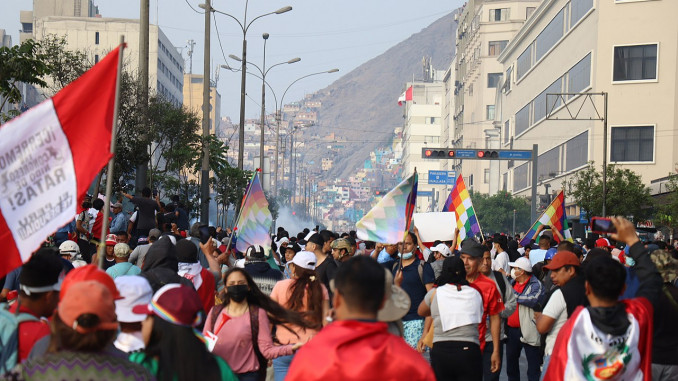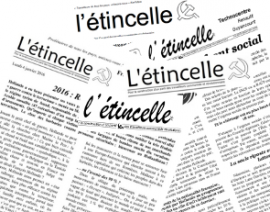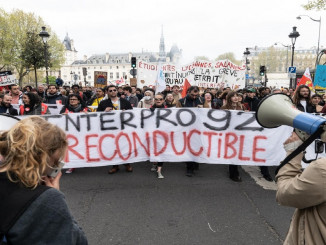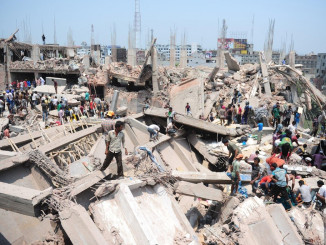
Since December 7, Peru has been rocked by major protests against the government. The indigenous majority of Peru, the most exploited and impoverished section of the population, have turned out in the thousands to protest the government’s decision to depose President Pedro Castillo. The roots of the protest run much deeper than simply support for Castillo, who was a deep disappointment to the aspirations and needs of the poor. The revolt in Peru is an expression of anger at the whole system of racist, corrupt, Lima-based politicians who line their pockets helping international corporations exploit Peru’s rich resources, while the poor and working class starve and suffer.
The 2021 Elections – A Political Earthquake
In the midst of the COVID-19 pandemic, the politicians in power were discredited, exposed as incompetent and corrupt. They had pocketed much of the money for COVID relief, and arranged for vaccines for themselves and their friends. When they stood in the elections, no one wanted to vote for them. The alternatives were marginal parties from the right and the left. One of the candidates was Pedro Castillo, a former primary school teacher from the state of Cajamarca. Castillo became a nationally-known figure as the leader of a school-teachers’ strike in 2017. In the 2021 election, he ran as the presidential candidate of a small left-wing party called Free Peru. Peru has a two-round presidential election. In the first round, Castillo won by a slim number of votes. His slogan, “No poor people in a rich country” resonated with the poor majority even though he was a political outsider. The other winner of the first round was Keiko Fujimori. Fujimori is the daughter of the much-despised dictator Alberto Fujimori who remains in prison for his crimes after he was overthrown by a mass movement in 2000. Faced with these two alternatives, many Peruvians voted for Pedro Castillo as a way to block Fujimori. They feared that she would free her father, and they would begin constructing a new dictatorship. Castillo was elected by a slim majority of 44,000 votes.
Peru’s Horrific Poverty and Suffering
Peru is a country in which a majority of the population live extremely precarious lives. Some 70% of Peruvians make their living in the informal economy, with no regular employment. During the COVID-19 pandemic, Peru experienced the worst mortality of any country in the world, with the most cases leading to the death of the victims. Due to the war in Ukraine, which disrupted food shipments and agricultural supplies, more than half of the population does not have sufficient food.
Castillo – a Historic Disappointment
Castillo’s election was a surprise and a shock to the political establishment in Peru. Peru has been historically dominated by the rich elite based in Lima who look down on the indigenous majority, especially in the Southern Andes where many people still speak the indigenous Quechua language. Castillo is from Cajamarca, of indigenous ancestry, and from the poor section of the population. For the racist, elitist political establishment in Lima, he was an invader and a threat. On the other hand, for the indigenous majority, they celebrated the fact that one of their own could make it into office.
In his electoral program, Castillo proposed to create a constituent assembly to re-write the constitution, carry out a program of land distribution to the poor, create a system of free higher education, levy taxes on the big mining corporations, and create a system of public pensions for retirement. During his year and a half in office, Castillo delivered none of these things. Instead, he staffed his cabinet with right-wing businessmen, and continued business as usual, giving important positions in the government to his family members. Castillo was disowned by his political party, Free Peru, as it became clear he had opportunistically presented himself as a reformer, just to achieve his own personal ambitions. Castillo’s presidency was a grave disappointment to those who had invested hope in him.
Castillo’s Attempted Coup
On December 7, Castillo announced his intentions to disband Congress and call for a constituent assembly to rewrite the constitution. Why, all of a sudden, did he decide to make this move? In fact, Castillo faced corruption charges that would have seen him removed from office. While these charges were probably well-founded, Peru’s political establishment is rancid with corruption. Politicians take bribes and hand out favors to their friends and family across the board. For the corrupt congressmen to accuse Castillo of corruption was deeply hypocritical. In response to their attempt to remove him, Castillo called to disband congress in order to protect his own power. Congress immediately moved to impeach him, installing his vice president, Dina Boluarte. Boluarte went along with this power-grab by Congress, and since December 7 she has presided over the most brutal application of state violence in Peru since the fall of the Fujimori dictatorship in 2000.
An Enraged Population
The rapid impeachment of Castillo, and the power-grab by congress, were one too many insults for the poor and working class to bear, especially in the impoverished regions of Peru. They had seen their hopes betrayed by Castillo, but they understood that the new government would offer nothing, without even the pretense of representing them. It was also a symbolic insult, that the Peruvian political establishment would not tolerate an indigenous president, even one who is just as corrupt as they are.
After the impeachment of Castillo was announced, thousands of people mobilized. In Cusco, Puno, and other Andean cities, protesters marched on police stations and blocked airports. The repression was extraordinarily harsh on the part of the police. On December 8, eight people were shot and killed in Ayacucho. On January 9, police shot and killed 18 people in the city of Juliaca in Puno. The death toll has steadily risen with 60 killed and thousands wounded. The message from the government is clear – the poor shall not have a say.
The Four Suyus March
With mass repression unleashed in the provinces, tens of thousands of people decided to hold a protest in Lima. As one protester from Puno put it, “Over there, we’re killed, over there no one listens to us. We have to come here to be seen.” On January 19, a mass march in Lima was called, with the name “The Four Suyus March”. That title comes from the indigenous Quechua language name for the four corners of the Inca kingdom. Many poor and working class people in Lima opened their homes, and their kitchens to those who traveled from the provinces. The students of San Marcos University seized their school premises to house thousands of rural protesters. The CGTP union called for a national strike on January 19 and 20, shutting down production, transportation, and business as usual in much of the country.
Violence is a Sign of Weakness
The elite political establishment in Peru is terrified. The violence that they have unleashed is a symptom of their weakness. They see a wave of revolt coming from below, and hope to scare people away by injuries, arrests, and killings. It is clear that behind the mask of democracy in Peru there is a dictatorship of the rich, struggling to maintain its power.
The Traps that Lay Ahead
The protest movement has made clear its demands. They want new elections, a new constitution, and to break the old political order that rests on corruption. This puts them in direct conflict not only with the political establishment, but the interests of international capitalism. For example, Swiss-owned Glencorp, and Chinese-owned MMG operate massive copper mines in Peru. American Lithium Corporation is developing mines for lithium, a key component of electric vehicle batteries. These companies, and many more, rely on the system of corruption in Peru to gain entry and steal away the natural resources, while leaving the population in poverty.
The danger in Peru, as in many other examples in Latin America, is that a successful restructuring of the government will be attempted by agents of the corporations. For example, in Chile, the mass protest movement of 2019 hoisted the supposedly left-wing Gabriel Boric into power, but his government has refused to touch the interests of the multinational corporations in that country.
Peru’s problems can only really be addressed if the poor and working class take power into their own hands, and seize the resources of Peru to benefit of the population. In spite of the hardships and repression, the protest movement in Peru is a hopeful one. In a movement such as the one we are see there, people learn to exercise their power. Organized and powerful, they begin to see the possibilities that go beyond what they may have expected. Rather than pressuring those in power to come up with more just solutions, the poor and working class of Peru could remake the society and impose their own solutions, and a government of the workers and poor. It is not only a hope for Peru. If the poor and working class of Peru break free of the domination of the big corporations and the fake democracy that serves them it will be an example seen throughout the world, including in the U.S.




